A portable projector gives you the option of taking big-screen entertainment with you wherever you go. Even if you’re just staying at home, a compact and lightweight projector is easier to take outside or move from room to room, giving you more versatility than bulky projectors designed to stay put once they’re installed.
If you’re looking for the most portable projector, the Xgimi Halo+ can run on battery power, expanding where and when you can use it.
The ViewSonic M2e is the absolute lightest option on the list, weighing just 2.2 pounds and with a slim 2.1” profile. If you want a portable projector with a high picture quality, the Epson EpiqVision Mini EF12 is a great choice. >>> Check on Amazon
The truth is, there are a lot of factors that go into choosing the best portable projector for your needs. Let’s look at the key considerations so you can decide which model is the right fit.
Best Portable Projector 2023 – Top Picks:
- Epson EpiqVision Mini EF12
- Epson EpiqVision Mini EF11
- Xgimi Halo+
- Xiaomi Mi Smart 2
- ViewSonic M2e
- Epson Home Cinema 880
| Epson EpiqVision Mini EF12 | Epson EpiqVision Mini EF11 | Xgimi Halo+ | Xiaomi Mi Smart 2 | ViewSonic M2e | Epson Home Cinema 880 | |
|---|---|---|---|---|---|---|
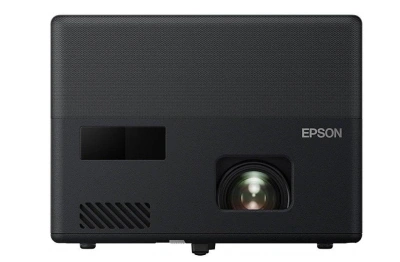 |
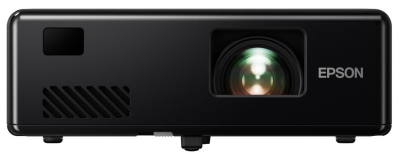 |
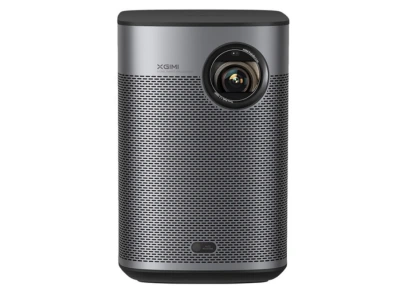 |
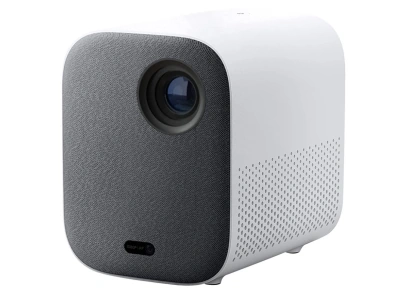 |
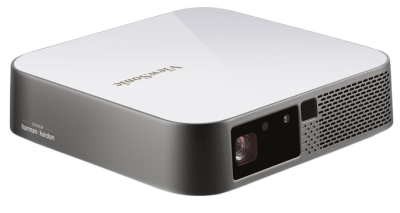 |
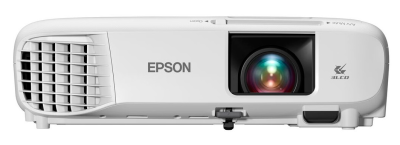 |
|
| Projector Size (HxWxD) | 5.30" x 6.90" x 6.90" | 2.60" x 6.90" x 6.90" | 6.75” x 5.7” x 4.5” | 5.9” x 4.5” x 5.9” | 7.2" x 7.2" x 2.1" | 3.20" x 11.90" x 9.30" |
| Weight | 4.7 lbs | 2.7 lbs | 3.5lbs | 2.9lbs | 2.2 lbs | 6.0 lbs |
| Resolution | 1920x1080 | 1920x1080 | 1920x1080 | 1920x1080 | 1920x1080 | 1920x1080 |
| Brightness (Lumens) | 1,000 | 1,000 | 900 | 500 | 400 | 3,300 |
| Contrast Ratio | 200,000:1 | 200,000:1 | 10,000:1 | No data | 3,000,000:1 | 16,000:1 |
| Throw Distance | 2.2' - 10.9' | 2.2' - 10.9' | 2.6' – 9.9' | 5.2' – 10.5' | 2.6' - 8.8' | 2.2' - 34.0' |
| Screen size | 30" - 150" | 30" - 150" | 30" – 113" | 60" – 120" | 30" - 100" | 25" - 386" |
| Price | BHPhotoVideo.com | BHPhotoVideo.com | BHPhotoVideo.com | Check on Amazon | BHPhotoVideo.com | BHPhotoVideo.com |
Brightness
One concern with many projectors designed for travel is that they’re not very bright, especially models that use battery power. This may not be an issue if you only plan to watch at night or in completely dark spaces. For daytime and lights-on viewing, though, you’ll want a projector that can produce at least 3,000 lumens to avoid picture wash-out.
The Epson Home Cinema 880 is the only option that exceeds this standard, putting out 3,300 ANSI lumens that will maintain a high picture quality in most indoor light levels.
Brightest Projector: Epson Home Cinema 880
Throw Distance
The throw distance of a projector tells you how far from the screen it needs to be to produce a large image. Most standard-throw projectors will give you a 100” screen with between 8 and 10 feet of distance.
A shorter throw distance won’t just be better for small spaces but can be more convenient in any space, giving you more flexibility in where you place the projector.
If you want a big image with the least distance possible, you’ll be best-off going with one of the Epson EpiqVision Mini models. While neither can be considered a “short-throw” projector, their unique lamp design gives you a 100” screen from about 7 feet away.
Shortest throw distance: Epson EpiqVision Mini EF11 and EF12
Sound
When you’re on the road, it’s convenient to not have to bring external speakers. All of these projectors have some kind of sound built-in, though in many cases this is a single speaker with 5 watts of power or less. That’s enough for basic TV watching but won’t give you immersive sound.
The exception to this is the EpsonEpiqVision Mini EF12. Its custom speaker enclosure and use of Dolby Audio processing give it both better sound quality and more volume than other projectors on the list.
You’ll also get better than average sound from the dual Harman Kardon speakers in the Xgimi Halo+, which include support for DTS-HD and Dolby Audio sound.
Best built-in sound: Epson EpiqVision Mini EF12
Streaming Capabilities
Similar to the sound, built-in streaming capabilities spares you the need to travel with thumb drives or streaming sticks. Most of these projectors come with Android operating systems for direct streaming. The systems on the Xgimi Halo+, Xiaomi Mi Smart 2, and Epson EpiqVision Mini EF12 are relatively robust and easy to navigate.
However, the ViewSonic M2e has a slightly different streaming system, using an Aptoide user interface that supports native streaming through Netflix as well as services like Amazon Prime and Disney+. It also supports screen mirroring from devices, expanding your options for wireless entertainment.
Best streaming: ViewSonic M2e
Best Portable Projector: Full Reviews
Epson EpiqVision Mini EF12
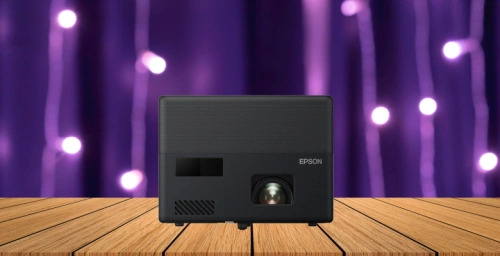
Pros
- Vibrant, accurate colors with no rainbowing or hot spots
- Quick and easy to set up
- Android TV interface supports direct streaming
- Yamaha sound system is impressive for the size
- Durable casing stands up well to travel
- Supports 4K content
Cons
- Low lamp brightness
- Doesn’t support content mirroring
The Epson EpiqVision Mini EF12 is designed to be a portable, all-in-one entertainment package so you can enjoy shows and movies anywhere. The built-in Android TV system lets you download most popular streaming apps, sparing you the need for external content sources.
You still have the option of connecting streaming sticks, gaming systems, and other devices, with 2 HDMI ports and a USB input.
The Epson EF12 has pretty good onboard sound, too, with a custom-designed Yamaha sound system and Dolby Audio support. The two 5-watt speakers are housed in a 3D enclosure that maximizes output, giving them a lot more oomph than you’d expect for the size and power. It’s especially strong in the mid-range, producing crisp, clear dialogue.
For the picture, the Epson EF12 uses a MicroLaser array with 3-chip color processing. This is paired with Adaptive Color Correction, which automatically adjusts the image scene by scene for natural, realistic colors, and the image overall is crisp and detailed with good contrast.
Our only issue from this perspective is the brightness. The lamp puts out about 1,000 lumens, enough for a clear picture in a dark space but too low to compete with ambient light. As long as you’re able to control the light level, though, you’ll get a cinema-quality picture from the EF12. Read our more detailed review of the Epson EF12.
Epson EpiqVision Mini EF11
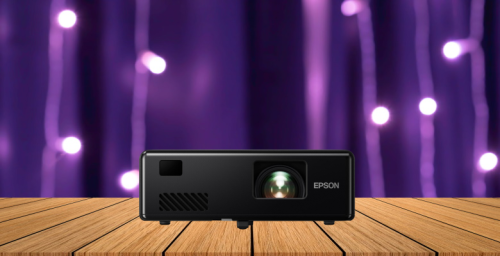
Pros
- Super-compact design
- Adaptive Color Correction optimizes color automatically
- Vibrant full HD picture with rich black levels
- Built-in sound is strong enough you won’t need external speakers
- Easy to set up and use
- Great value for the picture quality
Cons
- Wired input options are limited (1 HDMI port)
- Doesn’t support direct streaming
- Lamp isn’t very powerful
Another option from Epson’s EpiqVision line, the EpiqVision Mini EF11 is a slightly streamlined version of the EF12 above. Its strengths and limitations are similar. On the plus side, it uses a high-quality multi-array laser with 3LCD chip technology and Adaptive Color Correction.
In layman’s terms, that means you’ll get full HD detail with rich colors and sharp contrast. Its main weakness is that it’s not very bright, so you’ll only be able to enjoy that beautiful picture in a completely dark space.
Like its larger counterpart, the Epson EF11 has surprisingly great sound for its size. Its dual-speaker system includes a bass-reflex speaker that’s dedicated to the lower frequencies. While its low end can’t compare to what you’ll get from a full subwoofer, it’s far superior than the sound from most home theater projectors.
At less than 3 pounds, the Epson EpiqVision Mini EF11 is one of the most compact projectors you’ll find. That said, it’s not as self-contained as the EF12. You can’t stream content directly to the EF11. Instead, it’s designed to work well with a range of streaming sticks and services like Android TV, Apple TV, FireTV, and Roku.
That limits its versatility a bit, especially considering you’ll only get one HDMI port for your content. Click here for our more detailed review of the Epson EpiqVision Mini EF11.
Xgimi Halo+
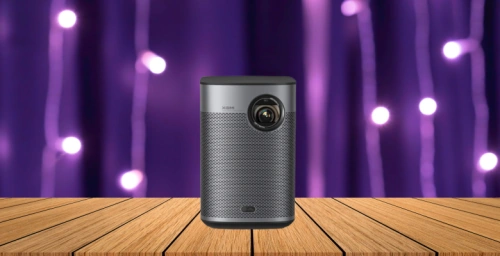
Pros
- Automatic keystone, focus, and alignment
- Premium sound from integrated Harman Kardon speakers
- Built-in Chromecast and Android TV streaming interface
- Supports 3D content
- Low enough lag for most gamers
- Google Assistant voice search
- Battery option with 2-hour run time
Cons
- Requires fully-dark space
- No 4K support
The compact size and light weight of the Xgimi Halo+ isn’t the only thing that makes it super portable. Its 59-watt battery has the capacity to play a full-length movie with each charge so you don’t need to be near an outlet to access your entertainment.
Along with this, it has built-in speakers and an integrated streaming interface with Chromecast support, so you won’t need extra equipment to watch your favorite shows and movies.
Setting up the Xgimi Halo+ is a fast and easy process. It boots up in seconds and has intelligent alignment features, automatically adjusting the focus, geometry, and placement of the image so you can get right to watching.
The included remote has a Google Assistant voice control option in addition to the standard buttons, giving users multiple ways to search for and play content.
The X-Vue 2.0 image engine of the Xgimi Halo+ produces a clear full HD image with good color accuracy and MEMC technology to reduce motion blur. While it can’t match the detail and sharpness of a full-sized projector, it does have HDR10 dynamic contrast, and the image quality is superior to many portable projectors.
It’s also versatile when it comes to content, with support for multiple 3D formats and a low enough input lag it can be used for gaming.
Xiaomi Mi Smart 2
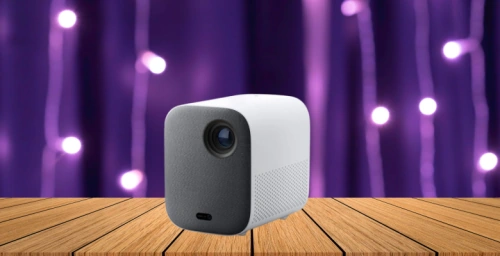
Pros
- Full HD image with excellent color
- Android streaming interface with Google Assistant
- Multi-angle keystone correction
- Dual 5-watt speakers with Dolby Audio
- Wi-Fi and Bluetooth connectivity
Cons
- Requires third-party device to use voice control
- Limited connectivity
The LED light source of the Xiaomi Mi Smart 2 is both a strength and a weakness. On the plus side, it produces accurate and nuanced color, with a color gamut wider than the Rec.709 spectrum, providing a realistic picture when combined with the full HD resolution.
It’s also very lightweight, keeping the projector’s total weight under 3 pounds. Unfortunately, it’s not as powerful as lamps or lasers, and can’t compete with even low ambient light levels without losing some picture quality.
One unique feature of the Mi Smart 2 is its multi-angle keystone correction, which corrects across 3 axises and 6 directions to ensure a square image even when the projector is tilted.
Combined with the automatic focus, this gives it a fast and flexible setup. It also has full wireless connectivity and an integrated Android TV streaming interface, though its wired connectivity is somewhat limited, with just a single HDMI and USB input.
The Xiaomi Mi Smart 2 supports Google Assistant voice control, but it’s not fully built-in—you’ll need a compatible device that supports Google Assistant on the same network to use this feature.
You won’t need external speakers, though, thanks to the dual-channel stereo speakers that come installed in it. They support both Dolby decoding and virtual surround sound for an immersive listening experience to match its big-screen visual performance.
ViewSonic M2e
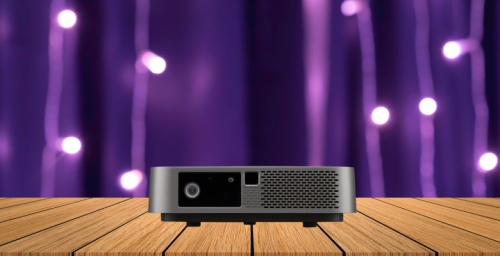
Pros
- Ultra-lightweight with slim profile
- Vibrant, realistic color with sharp contrast
- Good sound with Harman Kardon speakers
- Easy set-up with automatic focus and 2D keystone
- Intuitive Aptoid streaming interface
- Low maintenance with long lamp lifespan
Cons
- Low lamp brightness
- No built-in voice control
The ViewSonic M2e has a slim profile, just over 2 inches, and only weighs a little over 2 pounds. That’s small enough to slide into a briefcase for work meetings, or carry along in your backpack on road trips.
Its Aptoide UI supports direct streaming through popular services like Netflix, Amazon Prime, and Disney+, with a memory card slot for saved shows and movies along with an HDMI port and wireless connectivity options.
Both the sound and picture quality are high on the ViewSonic M2e. Its full HD resolution is backed by HDR support and a wide color gamut, exceeding the Rec. 709 spectrum.
The Harman Kardon speakers aren’t hugely powerful, but they get louder and sound better than the majority of portable projector speakers, with great dialogue clarity and decent low-end depth.
We also appreciate how easy the ViewSonic M2e is to set up. Its instant automatic focus keeps the picture clear, with both horizontal and vertical keystone to maintain a square picture when the projector is at an angle.
The only major downside is that it uses an LED light source and only puts out around 400 ANSI lumens. That means you’ll need a completely dark space and the picture washes out easily during lights-on viewing. This projector may also be the right pick if you’re looking for the best mini projector for iPhone.
Epson Home Cinema 880
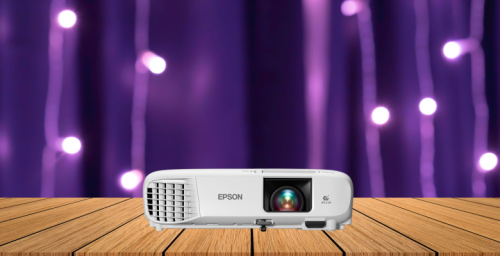
Pros
- High dynamic contrast for rich black levels
- Fast data processing prevents motion blur
- Bright and realistic colors
- Automatic picture skew adjustment
- Excellent value
Cons
- Limited connection options
- Long throw distance
For budget-conscious buyers, the Epson Home Cinema 880 is one of the best values you’ll find in a portable projector. It’s one of the most affordable Full HD projectors you’ll find on the market, and you don’t have to sacrifice a great picture for the price.
It uses much of the same picture technology Epson employs in their other models, including the 3LCD display technology and full HD resolution.
The plug-and-play operation of the Epson Home Cinema 880 means you’ll be able to start watching not long after you take it out of the box. It has the same automatic keystone correction you’ll find on the Epson 1080, giving it a good amount of placement flexibility and making it easier to align the image.
Its main limitation from a set-up perspective is that it only has 1 HDMI port for content, something that can be especially annoying if you ceiling-mount the projector and can’t easily access the HDMI port.
We have no quibbles with the picture quality of the Epson Home Cinema 880, especially considering the price. While it’s not the brightest projector on the list it’s lamp is powerful enough for lights-on viewing, with fast processing that keeps action sequence from blurring.
Read our more detailed review of the Epson Home Cinema 880.
The Verdict
Choosing the best portable projector ultimately comes down to what you’re looking for. All of the projectors reviewed above have their strengths, from the all-in-one capability of the Epson EF12 to the ultra-compact design of the ViewSonic M2e or the battery operation option of the Xgimi Halo+.
We hope this review and comparison has helped you decide which one is the best fit for you!
FAQs
Most options in the portable projector world top out at a brightness of around 1,000 ANSI lumens. The minimum brightness most will want from a portable projector is 500 ANSI lumens.
That’s still on the dimmer side compared to full-sized projectors, but will be enough power to maintain a clear picture in a mostly-dark setting.
Whatever the projector’s size, you tend to get what you pay for. This doesn’t necessarily mean cheap projectors aren’t any good, but you will sacrifice some picture quality and functionality once you get into the under-$500 price range.
The projectors listed here all fall in the $500-$1,000 price range, which is where most will want to budget for, especially if you want to get a full HD image with the smart features and streaming capabilities most users want from a portable projector. Both the Epson 880 and Xiaomi Mi Smart 2 are on the lower end of that price range for those who want high performance at an affordable cost.